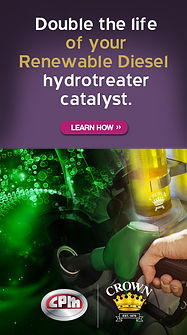- Topsoe
Technology spotlight: Topsoe’s HydroFlex™ helps Calumet become North America’s largest SAF producer

The demand for sustainable aviation fuel (SAF) is rapidly growing, with the International Aviation Transport Association estimating 120 billion gallons of SAF per year is needed for the airline sector to achieve net-zero CO2 emissions by 2050.
This compares to the estimated 75 million gallons of SAF produced in 2022.
Topsoe, a global leader in carbon emission reduction technologies, is dedicated to making a strong contribution to a decarbonized future, including in sectors that cannot be directly electrified such as aviation.
A recent example of this is Calumet’s Montana Renewables refinery in Great Falls, which is now operational producing both SAF and renewable diesel, for which Topsoe delivered its HydroFlex™ technology.
The production capacity of the Great Falls plant is about 630,000 gallons per day, and it produces a mixture of renewable jet and diesel, based on waste oils and other low-value feedstocks.
Calumet serves markets in Canada and the U.S. West Coast with low-emission fuels.
“It’s great to see the successful production of sustainable aviation fuel by Calumet,” said Henrik Rasmussen, Topsoe’s managing director for the Americas. “Actual production of SAF is crucial for decarbonizing aviation, and demand for SAF will only grow [for many years to come]. We’re excited to be working with the Calumet team on this very successful revamp to make renewable fuels.”
Bruce Fleming, CEO Montana Renewables and executive vice president of corporate development, added, “The production of renewable jet is another step toward our company’s strategic goal to help decarbonize the airline industry. It has been a good collaboration between the Calumet and Topsoe teams, and we are presently planning an expansion to further increase our SAF yield.”
Renewable fuels such as renewable diesel and SAF produce fewer greenhouse-gas emissions while performing the same as regular petroleum diesel or jet fuel.
They can be used as a drop-in fuel without modification to engines or infrastructure.
Renewable fuels are made from waste, animal fats, and used cooking oils, as well as organic materials such as soybean oil.
With HydroFlex™, customers can convert low-value feedstocks into drop-in renewable jet and diesel that meets all globally accepted specifications for these fuels.
The innovative HydroFlex™ process layout offers lower capital expenditure (capex), but also a lower energy consumption during operation, resulting in a lower carbon-intensity (CI) score.
Topsoe’s HydroFlex™ can be deployed in both grassroots units and revamps for coprocessing or standalone applications.
“HydroFlex™ is by far the most successful renewable fuels technology globally,” Topsoe stated.




















-adjusted-to-spec.jpg)



